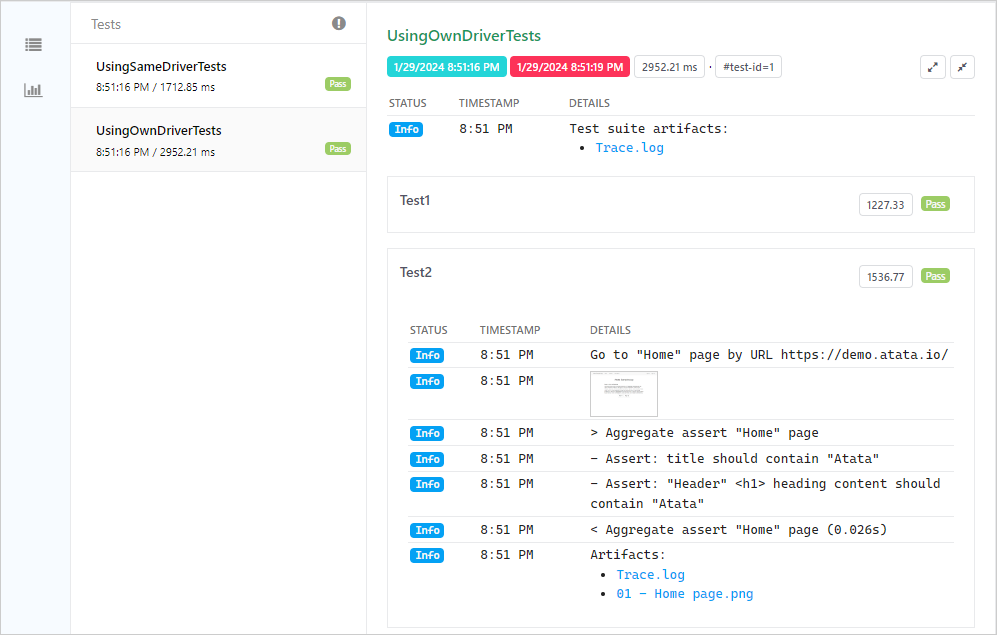Reporting to ExtentReports
How to configure Atata reporting to ExtentReports.
Packages
In addition to Atata package, the ExtentReports package should be added to the project. It is also recommended to add NLog package, as it’s used in the sample project.
Implementation
The functionality for ExtentReports is implemented in 6 class files:
- ExtentContext.cs -
the main static class responsible for an initialization of ExtentReports.
In this sample it attaches HTML reporter (
ExtentSparkReporter). Saves HTML report toAtataContextArtifacts root directory. Other Extent reporters can also be attached. - ExtentLogConsumer.cs - is responsible for reporting of log messages.
- AddScreenshotToExtentLogEventHandler.cs - adds screenshots to report.
- AddArtifactListToExtentLogEventHandler.cs - adds “Artifacts” list to report. Basically, a list of test artifact files, e.g., screenshots, snapshots, traces, etc.
- StartExtentTestItemEventHandler.cs -
creates/starts
ExtentTestnode. - EndExtentTestItemEventHandler.cs -
ends
ExtentTestnode.
You can copy all those files to your project and modify according to your project’s needs.
Later a separate Atata.ExtentReports NuGet package is planned to be created and published.
Configuration
In order to connect ExtentReports functionality to Atata,
a configuration of AtataContext.GlobalConfiguration can be done in SetUpFixture.GlobalSetUp.
SetUpFixture
ExtentLogConsumershould be added toLogConsumers.StartExtentTestItemEventHandler,AddScreenshotToExtentLogEventHandler,AddArtifactListToExtentLogEventHandlerandEndExtentTestItemEventHandlershould be added toEventSubscriptions.- To perform a generation of report file,
ExtentContext.Flush()method should be executed as a final action of a tests run. In NUnit a good place for it isOneTimeTearDownmethod ofSetUpFixture.
using Atata;
using Atata.ExtentReports;
using NUnit.Framework;
namespace AtataSamples.ExtentReports;
[SetUpFixture]
public class SetUpFixture
{
[OneTimeSetUp]
public void GlobalSetUp()
{
AtataContext.GlobalConfiguration
.UseChrome()
.WithArguments("headless=new", "window-size=1024,768")
.UseBaseUrl("https://demo.atata.io/")
.UseCulture("en-US")
.UseAllNUnitFeatures()
.LogConsumers.AddNLogFile()
.LogConsumers.Add<ExtentLogConsumer>()
.WithMinLevel(LogLevel.Info)
.WithSectionEnd(LogSectionEndOption.IncludeForBlocks)
.EventSubscriptions.Add(new StartExtentTestItemEventHandler())
.EventSubscriptions.Add(new AddScreenshotToExtentLogEventHandler())
.EventSubscriptions.Add(new AddArtifactListToExtentLogEventHandler())
.EventSubscriptions.Add(new EndExtentTestItemEventHandler());
AtataContext.GlobalConfiguration.AutoSetUpDriverToUse();
}
[OneTimeTearDown]
public void GlobalTearDown() =>
ExtentContext.Flush();
}
UITestFixture
UITestFixture is often used as a base UI test fixture class.
For this sample the implementation is more complicated as usual,
because additionally AtataContext for fixture is also added.
using Atata;
using NUnit.Framework;
using NUnit.Framework.Internal;
namespace AtataSamples.ExtentReports;
[TestFixture]
[Parallelizable(ParallelScope.Fixtures)]
public class UITestFixture
{
protected AtataContext FixtureContext { get; set; }
protected virtual bool UseFixtureDriverForTests => false;
[OneTimeSetUp]
public void InitFixtureContext() =>
FixtureContext = AtataContext.Configure()
.UseDriverInitializationStage(AtataContextDriverInitializationStage.OnDemand)
.Build();
[OneTimeTearDown]
public void DisposeFixtureContext() =>
FixtureContext?.Dispose();
[SetUp]
public void SetUp()
{
var testContextBuilder = AtataContext.Configure();
if (UseFixtureDriverForTests)
testContextBuilder
.UseDriver(() => FixtureContext.Driver)
.UseDisposeDriver(false);
testContextBuilder.Build();
}
[TearDown]
public void TearDown() =>
AtataContext.Current?.Dispose();
}
Tests
Tests Using Own Drivers
using Atata;
using NUnit.Framework;
namespace AtataSamples.ExtentReports;
public class UsingOwnDriverTests : UITestFixture
{
[Test]
public void Test1() =>
Go.To<HomePage>()
.Report.Screenshot()
.Header.Should.Contain("Atata");
[Test]
public void Test2() =>
Go.To<HomePage>()
.Report.Screenshot()
.AggregateAssert(x => x
.PageTitle.Should.Contain("Atata")
.Header.Should.Contain("Atata"));
}
For testing purposes, screenshots are captured right after a navigation to the home page. Also when the test fails at any moment, a screenshot is captured as well.
Tests Reusing Driver
In this test fixture class we create one shared driver for all class tests,
do navigation once in SetUpFixture method,
then every test starts with already navigated page
and does its verification.
using Atata;
using NUnit.Framework;
namespace AtataSamples.ExtentReports;
public class UsingSameDriverTests : UITestFixture
{
protected override bool UseFixtureDriverForTests => true;
[OneTimeSetUp]
public void SetUpFixture() =>
Go.To<SignInPage>();
[Test]
public void Email() =>
Go.On<SignInPage>()
.Email.Should.BeVisible();
[Test]
public void Password() =>
Go.On<SignInPage>()
.Password.Should.BeVisible();
}
Results
After a tests run, the generated Extent HTML report can be found by relative path:
\AtataSamples.ExtentReports\bin\Debug\net6.0\artifacts\{DATETIME_OF_RUN}\Report.html.
